Biology
Biology Concepts ? disease, vaccination, single nucleotide polymorphisms
- # 63 Summary Of Immunity
1 Phagocytes and lymphocytes are the cells of the immune system. 2 The diagram shows how to recognise phagocytes and lymphocytes in microscope slides and photomicrographs of blood. 3 Phagocytes originate in the bone marrow and are produced there throughout...
- #57.2 Immunity - Syllabus 2016
11.1 The immune system 11.2 Antibodies and vaccination An understanding of the immune system shows how cells and molecules function together to protect the body against infectious diseases and how the body is protected from further...
- #55 Infectious Diseases And Antibiotics
An infectious disease is one that can be passed between one person and another. Infectious diseases are caused by pathogens. These are usually microorganisms such as viruses, bacteria, fungi or protoctists. A non-infectious disease cannot be passed between...
- Immunity And Immune System
IMMUNE SYSTEM It is the system that gives immunity to the body by recognizing, responding and remembering foreign antigens. It plays role in allergic reaction, auto-immune disease and organ transplantation. It includes lymphoid organs, tissues, cells...
- Your Body Has A Photographic Memory
Biology Concepts ? innate immunity, acquired immunity, memory response, influenza Your body is exposed to tens of thousands of foreign molecules every day. Some can do you harm, some can?t. Your immune system sorts them by matching receptors on immune...
Biology
Lucky For Me, I?m Diseased
Biology Concepts ? disease, vaccination, single nucleotide polymorphisms
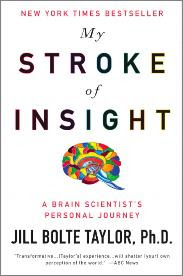 |
Jill Bolte Taylor is an Indiana University neuroscience professor who suffered a massive stroke. She recognized what was happening and has translated her thoughts and feelings into a narrative to help us understand. She is eloquent in describing how her stroke has affected her in a positive way. --- Soon to be a major motion picture! |
Yourarely hear someone say how glad they are to be sick ? unless a business meeting, unit test, or visit to the in-laws is involved. Robust health is a sign of good genes, and animals (including humans) instinctually seek out good genes when selecting mates. We don?t like to be sick, and we don?t want others (potential mates) to see us being sick.
True, there is that one person in a thousand who argues quite eloquently that an illness showed them another side of life, expanding their world-view and making them a better person. I applaud this attitude, but did you ever notice that it?s only the survivors that can gain this insight?
Our entire health care system is based on the idea that it is preferable to not be sick. The best way to bring this about is to reduce the chances that we will encounter anything that might provoke a response from our body, including pathogens (disease causing organisms, from pathos = disease and genique = to produce) and allergens (living or non-living molecules that can induce an allergic response).
But what does it mean to be ?sick?? If you are infected by a pathogen, are you necessarily sick? There are infections that are subclinical or asymptomatic (without signs of disease), and there are carrier states, when a person is infected and can transmit the disease, but does not have symptoms. Are these people still sick?
You can be in a social situation where you feel empathy or regret, ?I feel just sick about how I treated her.? Is this true sickness? Your mental state of mind is important in your health; if you talk yourself into being sick, are you really sick?
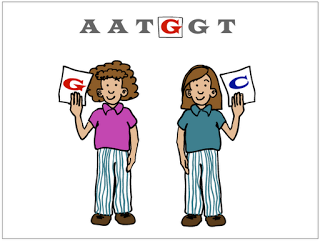 |
Single nucleotide polymorphisms (SNPs) are one base changes in a gene sequence. ?Polymorphism? means that the population will show different sequences at this point. SNPs may produce no change in the protein, but in some cases they may change the shape or function of the protein just slightly. This may not cause disease, but may affect the course of a disease, or how drugs will work in that individual. SNPs may one day lead to personalized medicines in a new science called pharmacogenomics. Drugs will be designed to work best for your particular DNA sequence. |
What about genetic mutations? Can everyone with a genetic mutation be considered sick? If yes, then we are all sick, because everyone one of us has thousands, perhaps millions of single nucleotide polymorphisms (differences in a single base of DNA that might lead to change in function of a protein). I would suspect that most of us have larger mutations as well; the older we are, the more mutations we have. Some mutations render a person predisposed (more likely) to develop a disease ? is this person sick even before he/she acquires the illness?
Osteoarthritis is a disease that can wear away joint surfaces and necessitate hip or knee replacement. My father has two artificial hips due to osteoarthritis, but does that make him sick or ill?
You see someone coughing, sneezing and blowing his/her nose. It could be due to respiratory allergies or a bacterial or viral infection. Are they sick in one instance, but not the other? I have seen TV ads that try to convince allergy sufferers that they are a menace to society, and should be embarrassed about their condition (unless they use their wonderful product). The entirety of the message in our society is that any illness or condition is a deficit.
To summarize our man-made rule: diseases are bad, and being exposed to diseases is bad, so keep your environment clean and antiseptic. Don?t get me wrong ? I am not mocking the rule. I would rather not be sick - so much so that I am careful where I go and what I touch ? in some places I simply choose not to breathe, just to be on the safe side. Disease prevention is an important part of life expectancy.
But are there exceptions? Is it sometimes good to get sick, either in general or with some specific disease? I think you know there must be exceptions, otherwise we would just be left with an interesting discussion of what it means to be sick. I bet you can even come up with at least example on your own. There are in fact boatloads of general and specific exceptions to this rule. Let?s take a few weeks and cover a few examples that are exceptions to "disease is bad" rule.
Our first exception is one that you may have already thought of ? vaccines. With many vaccines, getting the disease is the key to not getting the disease ? counterintuitive, isn?t it? I will use smallpox as an example of the idea that sickness prevents sickness, but there are many others.
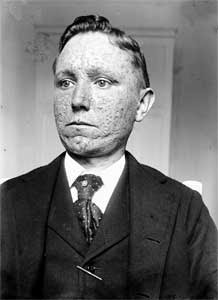 |
Smallpox survivors had a very distinct look. It was unfortunate that the lesions showed up most heavily on the face and arms. Thankfully, the disease has been eradicated, and the virus only exists now in two laboratories, at the Centers for Disease Control in Atlanta and the ?vector? lab in Siberia. Whether these stocks should be destroyed is a matter of some debate. |
Smallpox, until recently, had been a scourge on mankind for thousands of years. The infection is caused by a virus (Variola major or minor) and may present in several different forms. It was a very dangerous disease, the hemorrhagic form was almost universally lethal. Those that survived smallpox were marked for life (see picture).
In the 1790?s, Edward Jenner of Gloucestershire, England noticed that milk hands and milkmaids seemed to be immune (from Latin, immunis = exempt) to smallpox and he wondered why that might be. The milking workers told him they felt protected because they worked with diseased cows, those that had a mild disease called cowpox. For some reason, having had cowpox kept the milkmaids from catching smallpox.
It turns out that cowpox and smallpox are enough alike that having one will prevent you from having the other. It was on this basis that Jenner developed the first vaccine (Latin from vaccinus = from cows, coined by Louis Pasteur as a tribute to Jenner). By pricking the skin of a young boy with a needle contaminated with the pus from a young milkmaid with cowpox, Jenner showed that this could prevent infection with smallpox (Jenner wasn?t the first to vaccinate with cowpox, just the first to prove it prevented smallpox).
Contracting cowpox, a mild disease that did not kill or scar, could prevent one from catching smallpox, a terrible disease that often killed and left survivors with permanent reminders of their ordeal. Maybe getting sick ain?t always so bad. We will talk more next week about just how vaccination works to produce a protective immune response.
Cowpox vaccination is an example of using one disease to prevent another, but even 100 years before Jenner it was recognized that you could prevent smallpox by giving people smallpox. Strange, isn?t it? Variolation was performed by blowing ground smallpox scabs up the nose of another person, or by pricking them to place the material under the skin.
The virus in the olds scabs was definitely variola, it was just weakened (attenuated) by its age and its time outside of healthy cells. The virus was recognized by the body and an immune response is mounted, but the virus was too weak to produce a fulminant infection was eliminated by the body. But not before it helped the vicitim become immune to subsequent smallpox infection.
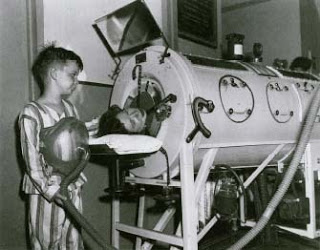 |
Poliomyelitis infection led to a paralysis of the muscles. This could include the respiratory muscles, so iron lungs were used to force air in and out of the patients? lungs. Before a vaccine was developed, a treatment was developed by an unaccredited nurse from Australia. Sister Elizabeth Kenny overcame much professional and gender prejudice to show that heat and passive exercise to retrain muscles was better than the then used immobilization therapy. Try to see the biopic ?Sister Kenny? on TCM some time. |
Attenuatedvaccines do carry some risk. Paralytic poliomyelitis has almost been eradicated thanks to Jonas Salk?s inactivated (dead) vaccine injections and Sabin?s orallly taken, attenuated vaccine. The attenuated vaccine is better at preventing a natural infection, but in rare cases the vaccine virus can revert back to a wild form and result in iatrogenic (iatro = doctor and genique = to cause) polio, also called vaccine associated paralytic poliomyelitis (VAPP). Thankfully, widespread use of the Salk and Sabin vaccines in the 1950?s has made vaccination in the US (as of 2000) and UK (2004) unnecessary.
Many of the vaccines used today are engineered in a laboratory from just a portion of the organism. By using only the antigenic portion (that part that elicits an immune response) of the virus, there is no risk of iatrogenic disease. If the viral portion is produced in a laboratory using DNA technologies, it is called a recombinant vaccine. In some cases, the antigenicpart of the virus is weak on its own, so these subunit vaccines may be conjugated (joined to) some other molecule that will elicit a stronger immune response.
Unfortunately, there is a growing number of people ignoring history and putting are their children and the population at large at risk. Some parents? reluctance to vaccinate is based on a single 1998 study in which vaccination was linked to autism, even though the author of the paper, Andrew Wakefield, has been convicted of scientific fraud and banned from the practice of medicine. Wakefield was an investor in a company that was going to offer medical testing for vaccine-associated autism and as well as assist in autism/vaccine lawsuits, so he falsified his data in an effort to make his company profitable.
As a result of the vaccine scare, the UK has seen a rise in the number of measles, mumps, and rubella cases in the last decade. These are diseases associated with childhood, but can cause severe disease or death in many victims, especially adults.
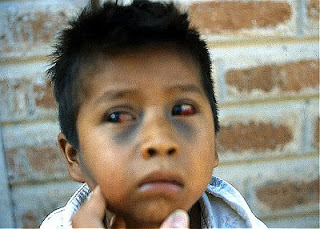 |
Pertussis, also called whooping cough, is transmitted only from person to person. If no around you has it, you can?t get it. However, symptoms may not show for 6 weeks after infection, so everyone should be vaccinated. The coughing can be so violent that it breaks blood vessels around the eyes and nose ? and it can kill young children. |
Manyin the US are also selecting to apply for vaccination exemption due to medical, religious, or personal beliefs; therefore, disease incidence is rising in America as well. In July, 2012, the CDC reported that the US had 18,000 cases of pertussis (whooping cough) in the past year, including an epidemic of more than 2500 cases in Washington state from January to June. This points out the need for vigilance in monitoring, as some of these patients had been vaccinated. This suggests that that the protection may not be lifelong; a booster vaccination may be necessary, although it is also telling that Washington state has one of the highest vaccination exemption rates in the country.
Next week we will look at vaccine driven immune responses in a bit more depth, in an effort to understand why we have to get a flu vaccination every year.
Centers for Disease Control and Prevention (CDC) (2012). Pertussis epidemic - washington, 2012. MMWR. Morbidity and mortality weekly report, 61, 517-22 PMID: 22810264
For more information on these subjects, or classroom activities, see:
Sick/diseased/ill:
http://rheumablog.wordpress.com/2011/04/02/sick-vs-chronically-ill/
http://genetics.thetech.org/about-genetics/mutations-and-disease
http://www.nytimes.com/2012/05/18/science/many-rare-mutations-may-underpin-diseases.html
http://learn.genetics.utah.edu/content/disorders/whataregd/
Single nucleotide polymorphisms and pharmacogenomics:
http://ghr.nlm.nih.gov/handbook/genomicresearch/snp
http://www.ornl.gov/sci/techresources/Human_Genome/faq/snps.shtml
http://www.youtube.com/watch?v=9rPDa2ACtog
http://serc.carleton.edu/genomics/units/snp.html
www.biotech.iastate.edu/publications/mendel/ModuleIIP1.pdf
http://teach.genetics.utah.edu/content/health/pharma/snp_analysis.html
http://teach.genetics.utah.edu/content/health/pharma/exploring.html
http://teach.genetics.utah.edu/content/health/pharma/mapping.html
http://teach.genetics.utah.edu/content/health/pharma/module_guide.html
Vaccines:
http://www.pbs.org/wgbh/nova/teachers/activities/2909_meningit.html
http://www.historyofvaccines.org/content/educators
www.centreofthecell.org/lessonplans/New_Vaccines.pdf
http://www.google.com/url?sa=t&rct=j&q=&esrc=s&source=web&cd=8&ved=0CFwQFjAH&url=http%3A%2F%2Fwww.historyofvaccines.org%2Fsites%2Fdefault%2Ffiles%2Finline-pdfs%2FHistory_of_Vaccines_How_Vaccines_Work.pdf&ei=2I8pULWaI6OxyQHmz4GYBg&usg=AFQjCNHCWt12nRDNdLuYWk-lhPa0bhgiug
www.chop.edu/service/vaccine.../vaccine-information-for-educators/
http://www.niaid.nih.gov/topics/vaccines/understanding/pages/typesvaccines.aspx
http://www.historyofvaccines.org/content/articles/different-types-vaccines
http://health.howstuffworks.com/wellness/preventive-care/vaccine2.htm
Lack of vaccination:
www.pbs.org/wgbh/pages/frontline/health-science-technology/the-vaccine-war/why-arent-parents-vaccinating-their-children/
http://www.forbes.com/sites/gerganakoleva/2012/03/14/vaccine-debate-acknowledged-explained-at-global-conference/
http://www.parenting.com/article/the-end-of-the-autismvaccine-debate
http://www.nytimes.com/2011/04/24/magazine/mag-24Autism-t.html?pagewanted=all
http://www.guardian.co.uk/society/2012/jan/05/andrew-wakefield-sues-bmj-mmr
www.pbs.org/wgbh/pages/frontline/teach/vaccine/vaccine.pdf
- # 63 Summary Of Immunity
1 Phagocytes and lymphocytes are the cells of the immune system. 2 The diagram shows how to recognise phagocytes and lymphocytes in microscope slides and photomicrographs of blood. 3 Phagocytes originate in the bone marrow and are produced there throughout...
- #57.2 Immunity - Syllabus 2016
11.1 The immune system 11.2 Antibodies and vaccination An understanding of the immune system shows how cells and molecules function together to protect the body against infectious diseases and how the body is protected from further...
- #55 Infectious Diseases And Antibiotics
An infectious disease is one that can be passed between one person and another. Infectious diseases are caused by pathogens. These are usually microorganisms such as viruses, bacteria, fungi or protoctists. A non-infectious disease cannot be passed between...
- Immunity And Immune System
IMMUNE SYSTEM It is the system that gives immunity to the body by recognizing, responding and remembering foreign antigens. It plays role in allergic reaction, auto-immune disease and organ transplantation. It includes lymphoid organs, tissues, cells...
- Your Body Has A Photographic Memory
Biology Concepts ? innate immunity, acquired immunity, memory response, influenza Your body is exposed to tens of thousands of foreign molecules every day. Some can do you harm, some can?t. Your immune system sorts them by matching receptors on immune...
